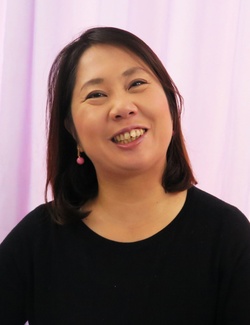"Investing in Japanese language education in kindergartens is highly effective," concludes Makiko Matsuda, an associate professor at Kanazawa University who is currently conducting a study on "the Japanese language usage characteristics of plurilingual speakers in Japanese communities in South America."
He was surprised to see that Japanese language schools in places like Pinhar and Pilar do Sul are "producing fairly advanced bilingualism," and he believes this is due to the fact that there are kindergartens and students attend Japanese language school almost every day.
In other words, what had been called "Japanese language education" in the colony was actually "bilingual education" from the perspective of Japanese experts.
He emphasizes that the secret to raising highly bilingual children is that "there will be a Japanese language environment. There will be groups of people speaking Japanese on a daily basis, and it is important that children learn to interact naturally there." "Learning Japanese strengthens the bonds with those who are older than them. There will be people with whom they want to use Japanese." "It is good to have a place where children can interact with grandparents in Japanese."
Pilar has revived its youth group, creating a place where seniors who can speak Japanese can be close to Japanese language school students. In addition, the former settlement was exactly such a bilingual environment. As I listened to the story, I realized that that is why many of the second generation who grew up before the war could read and write.
"What is needed to put effort into kindergartens that offer Japanese language education is bilingual picture books," Matsuda asserts. Picture books that contain stories that incorporate Japanese ways of thinking and ideas and that easily enter the minds of young children are important. Manga and anime may be taking their place these days, but good quality picture books still look good in the classroom.
"Even before we get to the issue of the technology for teaching Japanese, the content of textbooks and books written in Japanese must be appealing to children and adults alike, otherwise they won't jump at the chance," he said. I was so shocked that my heart nearly jumped out of my chest.
With this very thought in mind, I am currently editing the series "Japanese Culture." I choose the contents of the book by thinking every day about "what is Japanese culture that should be preserved?" and "what should be spread to the Japanese community as Japanese history." This comment hit the heart of my worries.
Japanese language education is ethnic education for children of Japanese descent, and elite education for ordinary Brazilians. In either case, the premise is that the students are achieving excellent results in the Brazilian curriculum. Portuguese develops logical thinking skills above average, and Japanese adds to that the unique way of thinking, culture, and education.
Matsuda says that the benefits of this are that "you can make decisions based on twice the information," "you can act as a mediator," and "it's easier to use your imagination by crossing the borders of Brazilian culture. It's easier to create a new culture that incorporates Japanese elements."
The difficult part is that "not everyone can become bilingual." "Because bilingual children have to process twice the amount of information as other people, they tend to lag behind in classes at the elementary school level. In the long run, it is important to first fully develop the main language, and then to fully acquire logical thinking skills.
After that, you can take the time to make them bilingual. If you watch over them with a kind eye, one day they will suddenly wake up." Parents and teachers who watch over them need to have a sufficient understanding and knowledge of bilingualism. "Depending on the child, it can be cruel to force them to be bilingual. Also, families need to have the financial means to provide a bilingual education," his words got me thinking.
"The Japanese language education that is being carried out in today's Japanese society is actually packed with amazing know-how. I think that Pilar's method, which starts from early childhood education and allows children to experience sports and culture at the same time, could be shared with the world in the future as a method similar to the 'Pilar Bilingual Education Method,'" he says.
Companies that want to secure talented Japanese talent for the next five or ten years might be better off offering financial support to schools like Pilar Japanese Language School now to get a handle on the situation.
The 110th anniversary of immigration kicked off on the 7th. We need to look ahead to the future, keeping in mind the achievements of more than a century since the start of immigration. Many of the people who will be supporting the 150th anniversary of immigration 40 years from now are undoubtedly studying at Japanese language schools now. Support the Japanese language schools around you and speak to your grandchildren in Japanese.
*This article is reprinted from the Brazilian community newspaper, Nikkei Shimbun (January 9, 2018).
© 2018 Masayuki Fukasawa






